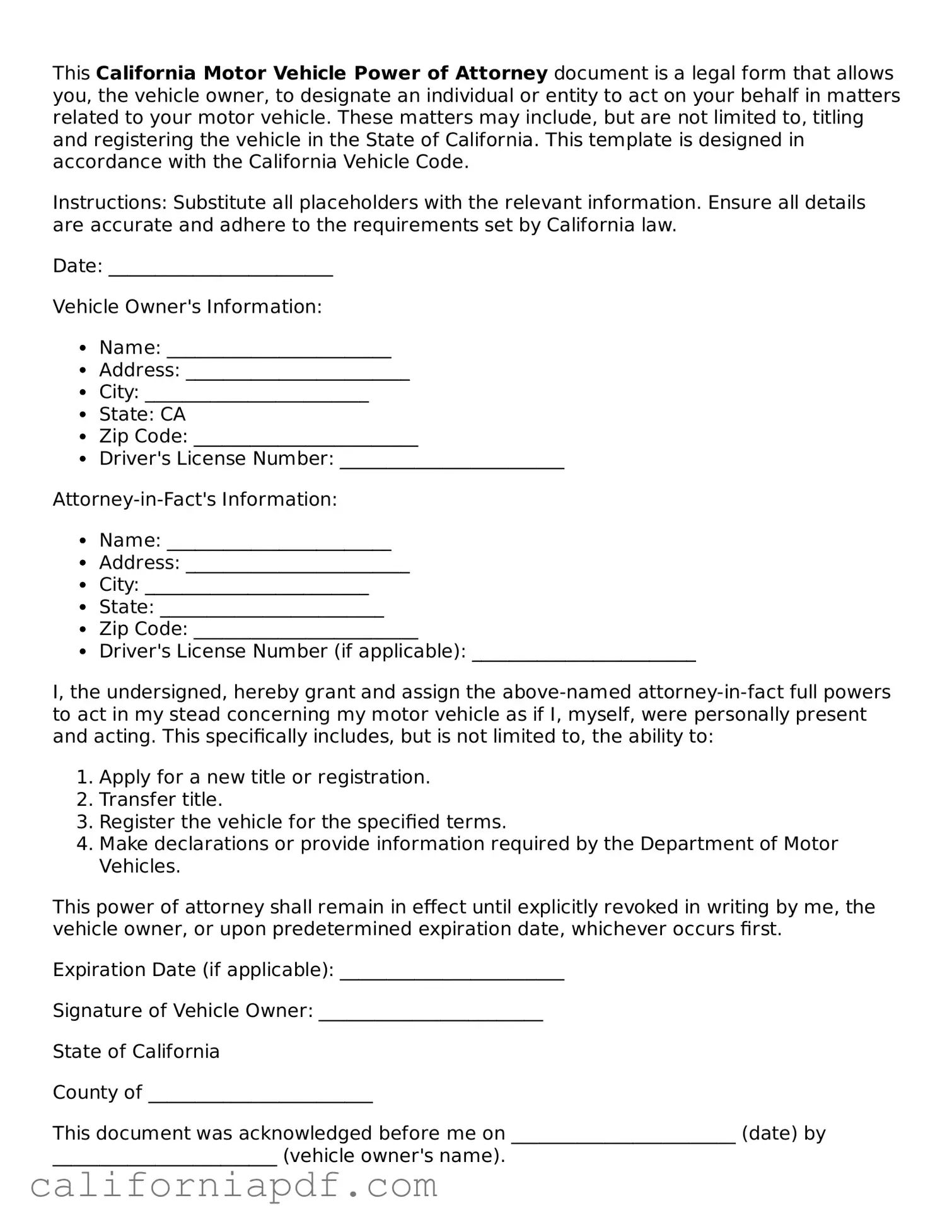The General Power of Attorney form, much like the California Motor Vehicle Power of Attorney, empowers an individual, known as the agent, to make decisions on behalf of another person, the principal. Where it differs is in its scope; the General Power of Attorney allows the agent to make a wide range of decisions, not just those relating to a motor vehicle, encompassing financial, legal, and personal matters until it is revoked or the principal becomes incapacitated.
Similarly, the Durable Power of Attorney form stands parallel to the California Motor Vehicle Power of Attorney, with the major distinction being its durability. While the Vehicle Power of Attorney focuses on vehicle-related transactions, the Durable Power of Attorney appoints an agent who retains power even if the principal becomes mentally incompetent or physically incapable of making decisions, providing broad or limited control based on the principal's directives.
The Limited Power of Attorney document shares its foundation with the Motor Vehicle Power of Attorney by allowing the principal to grant specific powers to an agent for particular tasks. The likeness lies in the limitation of powers, but while the Motor Vehicle POA is restricted to transactions involving vehicles, a Limited Power of Attorney could cover a range of limited activities, from handling a financial transaction to making medical decisions, based on what the principal specifies.
Health Care Power of Attorney forms, while focused on allowing an agent to make healthcare decisions for the principal, share the element of representation with the Motor Vehicle Power of Attorney. Both documents designate an agent with the authority to act on the principal's behalf, but the Health Care Power of Attorney is specifically tailored towards decisions about medical treatment and health care services in the event the principal cannot make those decisions themselves.
The Real Estate Power of Attorney document parallels the Motor Vehicle Power of Attorney in its function of granting an agent the ability to manage certain affairs for the principal. The difference mainly lies in the type of property under management; while the Motor Vehicle POA pertains to dealings with vehicles, the Real Estate Power of Attorney concerns itself with transactions involving real property, such as buying, selling, or leasing real estate.
Financial Power of Attorney forms mirror the specificity of the Motor Vehicle Power of Attorney, yet they encompass a broader range of financial responsibilities. This document authorizes an agent to handle the principal's financial affairs, including but not limited to, managing bank accounts, paying bills, and investing money. It can be made durable or springing, contingent on the principal's incapacitation.
The Springing Power of Attorney is comparable to the California Motor Vehicle Power of Attorney in its principle of delegating authority to another. However, its distinct feature is activation; it "springs" into effect under specific circumstances defined by the principal, such as a medical diagnosis of incapacity, unlike the typically immediately effective Vehicle Power of Attorney.
The Tax Power of Attorney form, similar to the Motor Vehicle Power of Attorney, narrows its focus to a specific domain, allowing an agent to handle tax matters on behalf of the principal. This includes signing tax returns, obtaining tax information, and dealing with the IRS directly. Though both serve to delegate authority in specific areas, the Tax Power of Attorney is strictly related to tax-related tasks.
Last but not least, the Child Care Power of Attorney provides a way for a parent or legal guardian to grant another individual the authority to make decisions regarding their child's care and welfare, echoing the representation aspect of the Motor Vehicle Power of Attorney. Nevertheless, this form's scope is much more personal, as it pertains exclusively to the well-being and care of minor children, from medical decisions to schooling matters.
